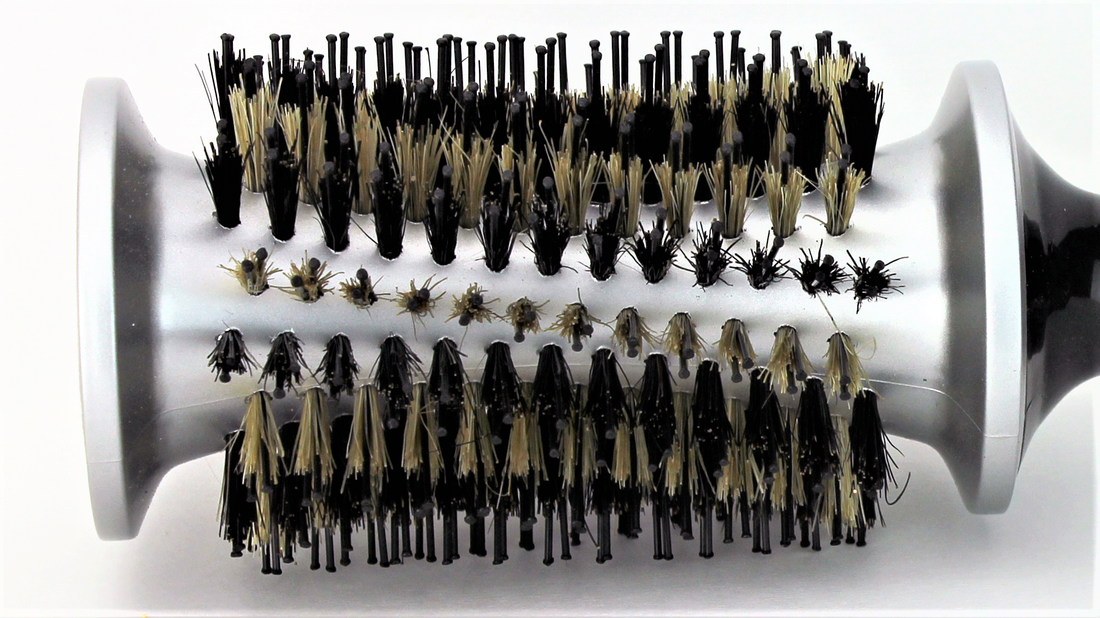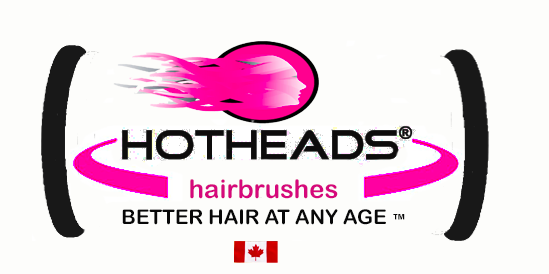
THE ANATOMY OF A HAIR BRUSH
Purchasing the right brush can solve and prevent more hair problems than you think. Getting the right brush is the KEY to improving your styling technique and the health of your hair.
What components make up a hairbrush a handle, barrel, and the bristles.
HANDLES: come in various shapes and sizes.
Handle length examine the length for a better balance. If the handle is too short, it may result in fatigue on your hands and arms while blow drying. Just think of a teeter totter if the handle is shorter than the barrel of the brush it is not balanced. A wider handle with a foam covering is suitable for those who have difficulty holding some brushes. Narrow Wood or Plastic handles can be difficult to grip and can create fatigue quickly.
BARREL: size is important when styling, to judge the size for curling, barrel size 13mm - 25mm 1/2“to 1” example for one full curl you will need 1 1/2 turns to create a full round curl shape. To smoothen hair barrel size is generally larger 70-80mm 2 3/4 " to 3” but it depends on the length of your hair.
Barrel Composition whether metal, ceramic, copper, graphene, or tourmaline coated these retain heat longer and may create more damage because they heat up and stay HOT longer. As well this type of brush allows hair to have direct contact with a hot metal surface resulting in heat damage.
Vented hairbrushes' are ultra light and supposedly dry hair faster, but when you place wet hair over a vented barrel can air from the dryer penetrate through it, does it?
A wood barrel is not very efficient for HEATING drying the hair or COOLING down faster.
BRISTLES they could be boar, nylon or a mix of both, metal and wood. and are one of the most important features of your brush. Something to use as a guide, the bristles should be slightly firmer than your hair but not so firm as to tear or break the hair. Fine hair needs to have a boar, nylon mix, but the bristles should be flexible. coarse, unruly, wiry or textured hair, the key words to look for are porcupine (a combination of synthetic and natural bristles, boar bristles only or a mix which tend to be stronger and firmer for penetration and grip. The nylon in a brush should be domed or have a finished tip not to scratch the scalp or break the hair . Please note natural boar bristle brushes on their own generally do not work for this hair type, unless they are reinforced with a nylon for extra grip and tension while styling.
General rule of thumb run your hand over the boar brush to feel the resistance of the bristles on your hand and ask yourself is this firmer than my hair or is it too soft? Run your hand through the rows of bristles to feel the characteristics of the bristles if you can't touch them don't buy it! Word of caution bristles that claim to be heat resistant do not address the health of your hair and claim not to melt at temperatures up to 485f, though heat damage starts to occur at 200f.
Wood bristles are generally used on a paddle type brush but be careful if they get wet the wood may splinter and tear your hair. These are not recommended for styling as they have very little grip when styling.
Metal bristles in a hairbrush why? There is zero flexibility and no grip in the bristles and will overheat if used to blow dry.
Profile of a boar bristle brush when purchasing look closely at the tips of the bristles. If they are flat like a toothbrush bristles, they will not penetrate and will be hard to control. staggered or irregular bristle tips will offer you more control, grip as the hair will fall into the bristles for more tension and control.
Bristle Pattern:
Some are straight rowed, though hair will not penetrate well and these will not work well on thicker hair.
Corkscrew pattern will create a versatile range for blow drying for mega volume or a sleek smooth finish putting you in control of your blow-drying.
Density of bristles too much bristling doesn't grip, likewise too little doesn't either.
All said and done when your hair is wet it stretches 50% of its length, and when it's dry only 20% of its length. It's the stretching that allows hair to set that's why wet styling is stronger than dry or heat styling.
The brush is often considered an afterthought but 90% of styling is done with your hairbrush, so take the time to review these tips on your next styling brush purchase.
“WHEN YOUR HAIR MATTERS™
”

